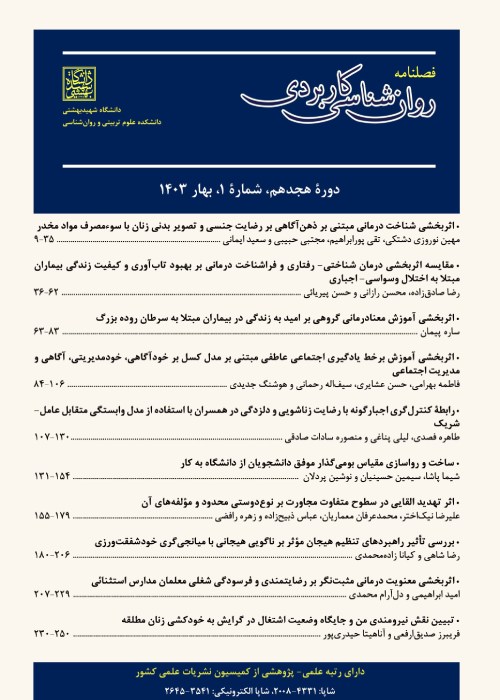Discrimination self-harming individuals from normal people based on positive and negative experiences, neuroticism and motivational values characters
Author(s):
Article Type:
Research/Original Article (دارای رتبه معتبر)
Abstract:
Aim
Present study purpose was to study role of positive and negative affective experiences, neuroticism and motivational values characters in descrimination self-harming individuals from normal people.
Methods
Research method was descriptive and, comparative causal type and the statistical population of this study was the students of dormitories at different universities of Tehran in 2016, where 218 of them (Between 30 to 50 participants from each of Tehran, Allame Tabatabai, Kharazmi, Shahed, Shahid Beheshti, and Tarbiat Modares universities) were selected by convenience sampling method. Finally, based on the Self-Harm Inventory of Sansone, Wiederman & Sansone (1998), 40 patients in the self-anxiety group and 40 patients in the normal group, they were screened and selected. The research tools consisted of the Positive and Negative Experiences Questionnaire, Diener, Writz, Tov, Kim-Prieto, Choi, Oishi & Biswas-Diener 2010, Schwartz Value Survey (1992), and NEO Personality Inventory 5 factors Costa & McCrae 1986 completed the test discriminant analysis was used to analyze the data.
Results
The findings showed that the mean neuroticism (F= 44.94, P= 0.001) and negative affect (F= 8.04, P= 0.006) of the self-harming group were significantly higher than the normal people, and the mean positive affect (F= 15.84, P= 0.001), universality (F= 8.96, P= 0.004), benevolence (F= 15.14, P= 0.001), tradition (F= 13.68, P= 0.001), conformity (F= 16.39, P= 0.001) and safety (F= 7.54, P= 7.54) were significantly lower than the normal group. The present discriminate function was able to explain 49.8% of the self- harming/ non-self- harming variance and coulde correctly grouped 91.3% of the participants.
Conclusion
The neuroticism, conformity, positive affect, benevolence, tradition, universality and negative affect variables can be used as a criterion to predict group membership of individuals in the normal group and the self- harm group and as a discrimination criterion for these two groups. Therefore, providing training to improve these variables can help moderate self-harming behaviors.Keywords:
Language:
Persian
Published:
Journal of Applied Psychology, Volume:12 Issue: 4, 2019
Pages:
553 to 571
magiran.com/p1938982
دانلود و مطالعه متن این مقاله با یکی از روشهای زیر امکان پذیر است:
اشتراک شخصی
با عضویت و پرداخت آنلاین حق اشتراک یکساله به مبلغ 1,390,000ريال میتوانید 70 عنوان مطلب دانلود کنید!
اشتراک سازمانی
به کتابخانه دانشگاه یا محل کار خود پیشنهاد کنید تا اشتراک سازمانی این پایگاه را برای دسترسی نامحدود همه کاربران به متن مطالب تهیه نمایند!
توجه!
- حق عضویت دریافتی صرف حمایت از نشریات عضو و نگهداری، تکمیل و توسعه مگیران میشود.
- پرداخت حق اشتراک و دانلود مقالات اجازه بازنشر آن در سایر رسانههای چاپی و دیجیتال را به کاربر نمیدهد.
In order to view content subscription is required
Personal subscription
Subscribe magiran.com for 70 € euros via PayPal and download 70 articles during a year.
Organization subscription
Please contact us to subscribe your university or library for unlimited access!


